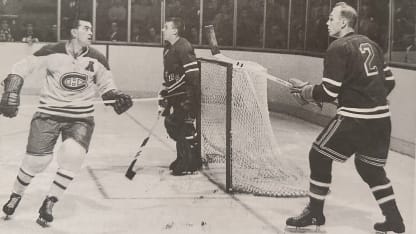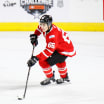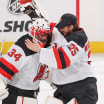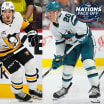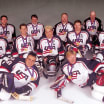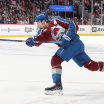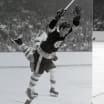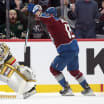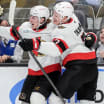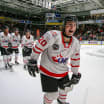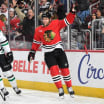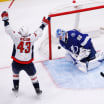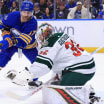Legendary hockey reporter Stan Fischler writes a weekly scrapbook for NHL.com. Fischler, known as "The Hockey Maven," shares his humor and insight with readers each Wednesday.
This week is the popular "Lists" segment and it examines hockey's nickname tradition dating back to before and during the days of the Original Six.
Here are the 10 best nicknames in alphabetical order, plus a bonus booby prize.
1. Max "The Dipsy-Doodle Dandy from Delisle" Bentley: A three-time Stanley Cup winner with the Toronto Maple Leafs from 1948-51, the jitterbugging center was a native of tiny Delisle, Saskatchewan. Bentley broke in as a member of the Chicago Black Hawks and played on the famed "Pony Line" with older brother Doug Bentley and Bill "Wee Willie" Mosienko.
2. Frank "Raffles" Boucher: This gem, attached to the legendary New York Rangers center, heads my "Obscure Pseudonym" list. A headliner on the 1928 and 1933 Stanley Cup champions, Boucher featured an exquisite talent for stealing the puck. In his time, Raffles was a popular fictional character created by author E.W. Hornung. He tabbed Raffles as a "gentleman thief who carried out ingenious burglaries," Raffles fit Boucher well since he was also hailed for his gentlemanly play and a frequent winner of the Lady Byng Trophy.
3. Bernie "Boom Boom" Geoffrion: Before reaching the NHL, the French-Canadian right wing honed his slap shot to sharpness as a Montreal Nationale Junior ace. After watching Geoffrion practice his shot one day, a Montreal reporter was impressed by the reverberations created by the puck hitting his stick and then the end boards. The scribe put the "Boom" and "Boom" together, inserted it in a story and from that point on, Bernie gave way to "Boom Boom" and later just "Boomer."
4. Glenn "Mr. Goalie" Hall: It's safe to say that Humboldt, Saskatchewan's, most famous citizen earned his nickname based on one career feat alone: Over eight NHL seasons, Hall played 502 consecutive regular season games without a mask or replacement. He also helped the Black Hawks win the Stanley Cup in 1961, their first title in 23 years. He was named a First Team All-Star goalie seven times, and three times had his name inscribed on the Vezina Trophy awarded to the best at his position. Playing for the expansion St. Louis Blues in the 1968 Stanley Cup Final, he proved worthy of his moniker by winning the Conn Smythe Trophy as MVP of the Stanley Cup Playoffs despite the Blues losing all four games to the Montreal Canadiens.
5. Ivan "The Terrible" Irwin: When Herb Goren became Rangers publicity director in 1950, he was looking for a tough stickhandler who fans in New York would love. Ivan Irwin was the rough and tumble defenseman who filled the bill. Goren immediately dubbed him "The Terrible" and Irwin made the label stick. On the one hand, Irwin was a fierce hitter, often tormenting champion scorer Maurice Richard. On the other hand, hockey critics couldn't help noting the big guy's skating style which was, in a word, "terrible."
6. Joe "The Duke of Paducah" Klukay: A fashion plate among the late 1940s Maple Leafs, Klukay claimed that he got the rare sobriquet from the team's press agent. "It was Ed Fitkin, our publicity director, who gave me that nickname," he told Larry Guerriero of the Sault Star in 1955, "and I guess it just stuck." Apparently, Fitkin admired Klukay's "Duke-like" wardrobe. Another Sault Star story described Klukay's "fine fashion style." An Ottawa Citizen story mentioned his "fancy street duds." (By the way, the original "Duke of Paducah" was Benjamin Francis Ford, an American country comic radio host and banjo player who was popular when Klukay was winning Stanley Cup championships with Toronto.)
7. Howie "The Mitchell Meteor" Morenz: Raw speed was Morenz's forte as a Canadiens center starting in 1923. One reporter christened him "The Mitchell Meteor" after his Ontario hometown. Others preferred "The Stratford Streak," coined when he played amateur hockey in Stratford, Ontario. Canada-based author Peter Gzowski wrote: "Howie had blistering speed and exciting headlong rushes." Others rated him "The first genuine NHL superstar of the 1920s."
8. Maurice "The Rocket" Richard: "I don't know who the first one was who gave him that 'Rocket' nickname," said former NHL goalie and Rangers coach/general manager Emile Francis, "but when he barreled down the right wing, he was like a rocket with eyes blazing." I'll add that Richard was the most exciting Original Six player I ever saw. His kid brother, Henri Richard, holds the NHL record for playing on 11 Cup-winning teams. Never quite as heart throbbing nor as physically big as Maurice, Henri was runner up in his French-Canadian family when it came to "nom de guerre." That said, "Pocket Rocket" fit Henri to a T.
9. Dave "Sweeney" Schriner: "He was the best left wing I ever saw," said Maple Leafs owner Conn Smythe. "That includes everybody -- Frank Mahovlich, Bobby Hull, Busher Jackson. Everybody!" Fine, but how did he get to be Sweeney? It turned out that his childhood idol in Calgary was a semipro baseball player named Bob Sweeney. Young Dave emulated his idol so much that neighbors called him "Lil' Sweeney." Schriner liked it so much, he never wanted to be called Dave anymore. The future Hockey Hall of Famer starred for Smythe's 1942 and 1945 Cup-winners.
10. Lorne "Gump" Worsley: When he was an aspiring goalie growing up in Montreal during the early 1940s, Worsley's friends said he looked like a character from a popular comic strip about an oddball family called "The Gumps." The strip's patriarch was its chinless, eccentric blowhard, Andy Gump, who claimed to have invented the flowerpot and introduced the polka dot tie in America. Worsley accepted the handle and by the time he starred for the Rangers his alias had replaced Lorne as his stage name and it remained that way through a long NHL career. (It didn't happen often, but I once heard someone warbling a tune from the "Funny Papers" to Worsley: "How do you do, Andy Gump, how do you do?") Worsley did very well, reaching the Hall of Fame as Lorne "Gump" Worsley!
BOOBY PRIZE: Is it possible that arguably a goalie who played only nine NHL games could wind up with the best nickname of all-time?
Steve Buzinski of Dunblane, Saskatchewan, was a World War II replacement for the goalie-starved Rangers during the 1942-43 season, He came from his job working for Agricultural Canada in Swift Current, Saskatchewan. In his spare time, Buzinski played goal for the Swift Current Intermediates until he arrived in the NHL.
At first. Buzinski appeared cocky about playing in the League. "It's the same as back home," he told reporters. "It's as easy as pickin' cherries off a tree." Shortly thereafter, he stopped a high backhander and nonchalantly tossed the puck to the side of the net. The trouble was it flew into his own net.
Buzinski allowed 32 goals in his first four games, losing 7-2 to the Maple Leafs, 12-5 to the Detroit Red Wings, a 4-3 win against the Canadiens and 10-4 to Montreal. He gave up a combined 20 in his final four games (0-3 with one tie). By then it was said that Buzinski had a sunburn on his neck caused by the perennial glow of the red light behind him.
That did it. Boucher had seen enough of the experiment and Buzinski was handed a one-way ticket back to Swift Current, where he resumed his job as a plant breeder.
The nickname that wins my booby prize is credited to United Press International writer Tim Moriarty.
STEVE BUZINSKI, THE PUCK GOES INSKI: When Buzinski was later asked about its origins, he replied "I have no idea at all. A lot of it is a figment of someone's imagination." There was nothing imaginative about going 2-6-1 with a staggering 5.89 goals against average. Let's face it, those pucks did go inski!
